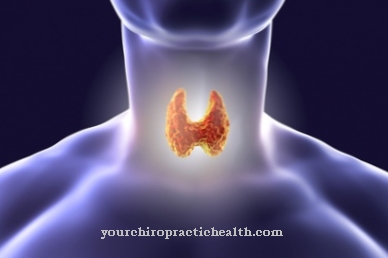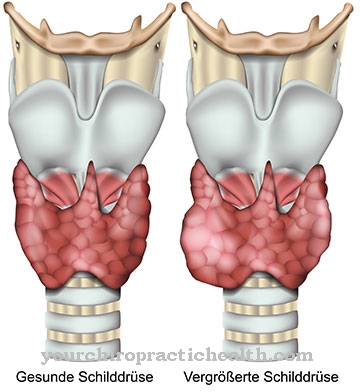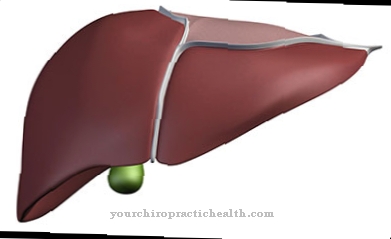Under one bruise (medical: Contusion) is the injury to tissue or organs caused by a blunt trauma such as a shock, kick or impact. Depending on the severity of the tissue damage, a distinction is made between a slight or a severe bruise. While minor bruises usually heal completely on their own, a doctor should be consulted if the contusion is severe.
What is a bruise?

An injury caused by blunt external force is called a bruise. The skin layer usually remains intact and there is no external bleeding. As a result of the trauma, soft tissues such as muscles or vessels are pressed against the bones and thereby squeezed.
Blood and lymph vessels can be damaged and fluid can enter the tissue. This leads to localized swelling and the formation of a hematoma (bruise). Bruises often occur on exposed parts of the body. A slight bruise usually only affects subcutaneous regions, i.e. the tissue that is directly under the skin.
With a severe bruise, anatomically deeper structures such as muscles, joints or internal organs are also affected. A well-known form of bruise is the so-called "horse kiss", which usually occurs on the thigh. Even if this generally heals without complications, in severe cases a compartment syndrome can occur, which must be treated surgically.
causes
A bruise occurs when external force acts on a part of the body in the form of a blow, punch or kick. Pinching can also cause tissue bruises. Contusions of varying degrees occur regularly, especially in contact sports such as soccer, handball, boxing or ice hockey.
Car accidents or falls on a bike are also possible causes. However, bruises can also occur as a result of household accidents or physical violence. Handicraft work also often results in bruises, especially in the area of the fingers or hands. Toes or ankles can also be affected if heavy parts fall on the feet. Bruises in the spine occur as a result of sprains in this area.
Symptoms, ailments and signs
The symptoms of a bruise depend on the part of the body affected and the severity of the injury. Classic symptoms that occur in most cases are bruises and swelling, as well as moderate to severe pain and tenderness.
External bleeding does not occur. Bruises in the musculoskeletal system can lead to restricted mobility. This is especially noticeable when the lesion is in the muscles or joints. If vessels are injured directly on the joint capsule, a so-called joint effusion occurs due to local bleeding. The consequences are often circulatory disorders and numbness in the affected area.
If the ribs are involved, pain-related breathing difficulties can result. Bruises on the eye show up as bruises ("violets"), bleeding of the conjunctiva or eyelid swelling.
Visual disturbances can also occur. Bone contusions are characteristically very painful at the beginning, but in most cases the pain quickly subsides. However, the skin may become sensitive over the long term.
Complications
While bruises are often viewed as "everyday" injuries, there are contusions that lead to serious consequences. Severe bruises can result in a so-called compartment syndrome (muscle compression syndrome, log syndrome).
Certain muscle groups are affected (compartments) that are surrounded by stabilizing connective tissue (fascia). Since fasciae are only slightly stretchable, strong tissue pressure builds up locally due to the muscle contusion. The resulting swelling impedes blood circulation within the affected muscle compartment, which results in an insufficient supply of the muscles with oxygen and nutrients.
In the worst case, an acute compartment syndrome can lead to neuromuscular disorders or tissue necrosis, i.e. tissue death. Without immediate emergency treatment, the bruised tissue can therefore be irreversibly damaged. If a severe compartment syndrome is left untreated for a long time, an amputation may even be necessary.
A distinction is made between a chronic compartment syndrome, which only leads to complaints in situations of physical strain and usually does not have any serious consequences. Another complication of severe bruises is life-threatening damage to organs in the abdomen or chest. Contusions of the brain as a result of severe traumatic brain injury can also have life-threatening consequences.
If hematomas develop that are located deep in the muscle tissue, the bleeding may be reduced less. The hematoma becomes encapsulated (calcification) and can lead to pain or impaired muscle function. In all cases, the risk of complications is reduced if first aid is provided quickly.
When should you go to the doctor?
A doctor should always be consulted after falls or accidents with strong violence in order to rule out internal injuries. This also applies if no major lesions can be seen at first glance. Even if pain does not decrease or worsens after immobilization and cooling of the injured body part, a doctor should not wait to clarify the diagnosis.
Further indications for a visit to the doctor are general malaise, dizziness, breathing difficulties, neurological restrictions (visual disturbances, paralysis), extensive hematomas or very strong pressure sensitivity of the bruised tissue. The same applies to severe restrictions on movement or loading difficulties in the extremities, as these can also be an indication of broken bones.
In the case of joint contusions, severe swelling of the injured region can cause critical circulatory disorders. This manifests itself as tingling or numbness in the area of the adjacent extremities. Since neurological structures can also be affected by tissue pressure, a doctor should be consulted directly if these symptoms occur.
Bruises of the spine must also be examined by a doctor in any case. If there is a known blood clotting disorder or if blood thinners are being taken at the time of the bruise, the person concerned should be monitored medically to prevent excessive bleeding into the tissue.
If infants or young children are affected, a doctor should always be consulted. A visit to the family doctor is sufficient for minor complications. In case of doubt, he can arrange for a referral to a specialist. In the event of sports injuries, an orthopedic surgeon or sports doctor can be consulted directly. In the event of severe complications and severe head injuries, an emergency doctor is the best option.
diagnosis
The diagnosis of a bruise is made using an elimination process, as the symptoms that occur are not specific. After the detailed clarification of the course of the accident (anamnesis) it must first be ensured that there are no broken bones or injuries to the internal organs.
In the case of head injuries, a traumatic brain injury must be excluded. As part of the further examination, the injured region is carefully palpated, the intensity of the pressure pain is analyzed and possible movement restrictions are recorded. The affected area should also be checked for skin injuries to prevent infection. Imaging procedures such as an X-ray examination, ultrasound or MRI (magnetic resonance imaging) can then be used to confirm the diagnosis.
Treatment & Therapy
The first aid is always carried out according to the so-called PECH rule: break, ice, compression, lying down. All physical activities should be stopped immediately to relieve the bruised body part.
The rest must be maintained in the long term until the symptoms subside. If the bruise is on the arms or legs, they should be elevated to prevent excessive fluid penetration into the tissue. A central treatment measure is always the cooling of the affected region with ice packs or cold compresses.
Ice sprays or cooling ointments are also often used. Continued cooling will reduce pain and swelling as the cold narrows blood vessels and reduces bleeding into surrounding tissue. The cooling should be interrupted regularly so that the wound healing can be activated in the cold-free phases. Swelling can also be reduced with a light pressure bandage. An adapted pain treatment can also take place.
The subsequent therapy depends on the severity and type of injury. If a large hematoma has formed as a result of a bruise, this can be punctured to reduce the pressure on the injured tissue. In severe cases, surgical removal of a hematoma can be useful to prevent inflammation. For this purpose, a drain is placed that drains excess fluid from the injured tissue.
After a reasonable recovery period, light massages or physiotherapy can be used in the final phase of treatment. Alternatively, ultrasound therapy can be used to improve blood flow to the bruised part of the body and remove potential adhesions within the hematoma.
A compartment syndrome must always be treated surgically. The skin and the underlying muscle fascia in the affected muscle compartment are surgically split as part of a so-called fasciotomy to take the pressure off the squeezed muscle tissue (decompression). Dead tissue can also be removed as part of this surgical procedure. The surgical wound is then covered and only closed again after the swelling has subsided.
Outlook & forecast
Usually the prognosis is good in the event of a bruise. Most bruises will heal completely within a few days to weeks without further complications. However, the individual prognosis is influenced by the degree of injury, the extent of the physical impairment, as well as the age and health constitution of the individual.
In general, it can be said that the prognosis improves with the rapid onset of therapeutic measures. The prognosis of any bruise can also be positively influenced by the immediate application of the PECH rule. In the case of untreated or incorrectly treated acute bruises, healing can be delayed and consequential symptoms such as calcification of the hematoma can occur.
Even in the case of serious complications such as compartment syndrome, the time at which the therapy is started is decisive for the further prognosis. An early fasciotomy is usually successful and free of complications. The tissue can regenerate completely. However, if the treatment is delayed, irreversible damage to the affected tissue and permanent functional impairment of the injured muscles can occur.
prevention
It is generally not possible to prevent a bruise. In contact sports such as hockey or soccer, bruises occur frequently and can hardly be prevented. In order to prevent the risk of injury, it is always advisable to wear suitable protective clothing (shin guards, knee pads, helmet). Prevention is also not possible in everyday life, as bruises usually result from accidents and the causes cannot be foreseen. When working in the trade, work shoes with steel caps can protect against bruises on the toes.
Aftercare
As a rule, a bruise heals on its own, so no specific follow-up measures are necessary afterwards. This applies to both light and quick healing as well as severe bruises. In rare cases, however, scarring changes can occur in the area of the bleeding in the case of severe bruises (contusions).
These should be observed when they occur and, if necessary, also assessed by a doctor. As soon as the bruise has completely subsided, you can start exercising again. With a slight bruise, this is usually the case after two to three weeks, sometimes even after days. However, a severe bruise can last around four weeks or more.
Therefore, even after successful treatment, a little rest should be given. Particular attention should be paid to the pain and, as the pain subsides, slowly begin to move. An early exercise stimulates the blood circulation, which can increase the swelling again.
Exercise should therefore never be started too intensively. It is advisable to wait 1-2 weeks before resuming exercise even after the pain has subsided and the treatment has apparently been completed. In addition, you should not go straight back on with full power, but begin with light movement. With an easy and not too early return to work, a bruise generally shows no long-term consequences or restrictions.
You can do that yourself
Most bruises are easy to take care of yourself. The therapy is also initially carried out according to the "PECH" scheme. After initial treatment, pain can be treated. Local treatments with diclofenac or ibuprofen are recommended for minor bruises. These active ingredients relieve pain and help prevent inflammation in the injured area.
Pain tablets can also be taken if the symptoms are more severe. However, acetylsalicylic acid (Aspirin®, ASA) should never be used for bruises, as this active ingredient inhibits blood clotting and can therefore intensify bleeding into the injured tissue. After the swelling has visibly decreased, cool chamomile tea compresses can be used to reduce inflammation and soothe the injured tissue.
Alternatively, zinc ointment can be applied to the affected areas of the skin to relieve the pain and help the bruise continue to swell. Arnica or comfrey ointments are also good alternatives. If the swelling has completely receded, it is advisable to warm the injured body region with warm rags or heat pads in order to stimulate blood circulation again and promote the natural regeneration of the bruised tissue.




.jpg)






















